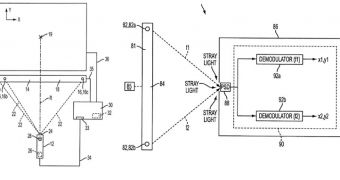A patent filing made by Apple in July this year, for a more reliable Apple Remote control system, has been recently made available to the public. Apple talks of a remote, similar to the Nintendo Wii's controller (the Wii Remote). However, Apple's device would be able to better distinguish predetermined light sources from stray ones.
"Some remote control systems use infrared (IR) emitters to determine the position and/or movement of a remote control," Apple says in the filing. "Such systems, however, often experience a common problem in that they may not be able to distinguish desired or predetermined IR light sources from undesirable environmental IR sources, e.g., the sun or a light bulb. Because those systems may mistake environmental IR sources for IR emitters, they may incorrectly determine the position and/or movement of the remote control."
However, such systems generally encounter issues, as they are not able to distinguish IR emitter from actual reflections of the IR emitter itself. Apple believes it can very well deliver such a device that can distinguish predetermined light sources from stray or unintended ones, such as reflections or other environmental sources.
“...the predetermined light sources can be disposed in asymmetric substantially linear or two-dimensional patterns," goes one embodiment of the invention. "Here, a photodetector can detect light output by the predetermined light sources and stray light sources, and transmit data representative of the detected light to one or more controllers,” the filing explains. “The controllers can identify a derivative pattern of light sources from the detected light indicative of the asymmetric pattern in which the predetermined light sources are disposed." The predetermined light sources could also output waveforms, modulated in accordance with signature modulation characteristics, according to the filing.
Credited inventors are Apple engineers Steve Hotelling, Nicholas King, Duncan Robert Kerr, and Wing Kong Low.

 14 DAY TRIAL //
14 DAY TRIAL //